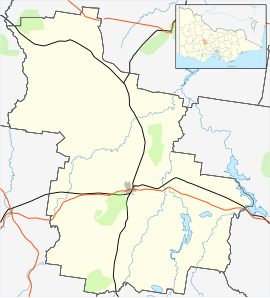Moliagul
|
Moliagul Victoria |
|
|---|---|

Miners and their wives posing with the finders of the largest alluvial gold find in the world, the Welcome Stranger.
|
|
| Coordinates | 36°45′0″S 143°40′0″E / 36.75000°S 143.66667°ECoordinates: 36°45′0″S 143°40′0″E / 36.75000°S 143.66667°E |
| Postcode(s) | 3472 |
| Location | |
| LGA(s) | Shire of Central Goldfields |
| State electorate(s) | Bendigo West |
| Federal Division(s) | Bendigo |
Moliagul is a small township in Victoria, Australia, 202 kilometres (126 mi) northwest of Melbourne and 60 kilometres (37 mi) west of Bendigo. The town's name is believed to be a derivation of the aboriginal word "moliagulk", meaning "wooded hill". The area is notable for the discovery of a number of gold nuggets. These finds include the world's largest, the Welcome Stranger, which was discovered in 1869 by John Deason and Richard Oates.
From what was once a thriving goldfields town, Moliagul today is a virtual ghost town and consists of a number of scattered houses. In 1855 it is estimated there were 16,000 people living in the immediate area during the peak of the Victorian gold rush period. Moliagul Post Office opened on 15 November 1858 and closed in 1971.
The town is composed of scattered rural dwellings and small farms, a hotel (now closed), museum, the old school (now a hall) and former church. There are a number of historical points of interest including a stone monument to the Reverend John Flynn, founder of the Royal Flying Doctor Service of Australia, who was born in Moliagul in 1880.
The nearby Moliagul Cemetery contains the headstones of many families, such as the Deason's, which date back to the gold rush times. Within a few kilometers of the town can be found various gold mining areas including the site of the Welcome Stranger.
Mount Moliagul itself is clearly visible from the town and offers superb views over the surrounding district.
...
Wikipedia

